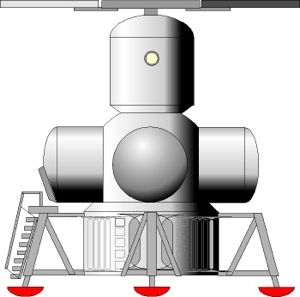
Home - Search - Browse - Alphabetic Index: 0- 1- 2- 3- 4- 5- 6- 7- 8- 9
A- B- C- D- E- F- G- H- I- J- K- L- M- N- O- P- Q- R- S- T- U- V- W- X- Y- Z
LZhM
 LZhM Credit: © Mark Wade |
AKA: Laboratorno-zhiloy modul';Vulkan-launched version. Status: Study 1973. Payload: 6,300 kg (13,800 lb). Gross mass: 21,500 kg (47,300 lb). Height: 9.70 m (31.80 ft).
Atop the landing stage was a four-lobed first story. Clockwise from the landing leg with the ladder to the surface, this consisted of cylindrical chambers containing: the airlock; crew washroom and kitchen; sample storage area; and control room. At the junction of the four cylinders was the crew dining and meeting table. Atop this was a two storied cylinder. On the lower story was the laboratory; atop this was the crew quarters. Total floor space devoted to work activities was 25 square meters, with 35 square meters devoted to crew quarters. The LLM would have been braked close to the lunar surface with the Block R stage, the descent stage itself only performing final descent and landing maneuvers. The crew would land in an LEK near the LLM and take up residence in it for up to a year.
Crew Size: 3. Habitable Volume: 160.00 m3. Electric System: 8.00 average kW.
Family: Lunar Habitats, Moon. Country: Russia. Spacecraft: LEK Lunar Expeditionary Complex. Launch Vehicles: Energia, Vulkan. Agency: Korolev bureau. Bibliography: 367, 89.
1975 January 1 - .
- Vulkan Lunar Base - .
Nation: Russia.
Related Persons: Barmin,
Bushuyev,
Glushko,
Mishin.
Program: Lunar L3.
Spacecraft: LEK,
Lunokhod LEK,
LZhM,
LZM.
Mishin and Barmin, using budget provided by the Ministry of Defence, had designed a lunar base for launch by the N1 in 1969-1974. After the cancellation of the N1, Glushko pleaded with the Military-Industrial Commission for the work to be taken from Barmin and be given to NPO Energia. Glushko's alternative, Vulkan-launched base was elaborated within his bureau. Bushuyev developed spacecraft for the base. Prudnikova developed a modular lunar city, with living modules, factory modules, a nuclear reactor power module, and a lunar crawler with a 200 km radius of action. The project work was only finally cancelled after the Apollo-Soyuz flights.
1977 December 1 - . Launch Vehicle: N1.
- Glushko uninterested in further lunar base work - .
Nation: Russia.
Related Persons: Bushuyev.
Spacecraft: Buran,
LEK,
Lunokhod LEK,
LZhM,
LZM.
Bushuyev tells Chertok that the lunar base work did not interest Glushko. The VPK Military-Industrial Commission was only interested in duplicating the American shuttle, not in any other ventures in space. With the N1-Sr booster, Russia could have had a six man lunar base established with 8 to 10 launches in the late 1970's. Bushuyev died on 26 October 1978, having seen his dream completely tossed away.
1978 January 1 - .
- Vulkan Lunar Base rejected - .
Nation: Russia.
Related Persons: Glushko,
Keldysh.
Spacecraft: LEK,
Lunokhod LEK,
LZhM,
LZM.
An expert commission led by Keldysh examines the plan for a lunar base launched by the Vulkan booster. The plan is completely rejected. NPO Energia was told to quit dreaming and devote itself only to projects with national economic importance, like Buran. This put a definitive end to Glushko's lunar base projects studied in 1976-1978. But he just waited and started design work again on a lunar base using the Energia launch vehicle after the first Buran launch in 1988.
Back to top of page
Home - Search - Browse - Alphabetic Index: 0- 1- 2- 3- 4- 5- 6- 7- 8- 9
A- B- C- D- E- F- G- H- I- J- K- L- M- N- O- P- Q- R- S- T- U- V- W- X- Y- Z
© 1997-2019 Mark Wade - Contact
© / Conditions for Use
